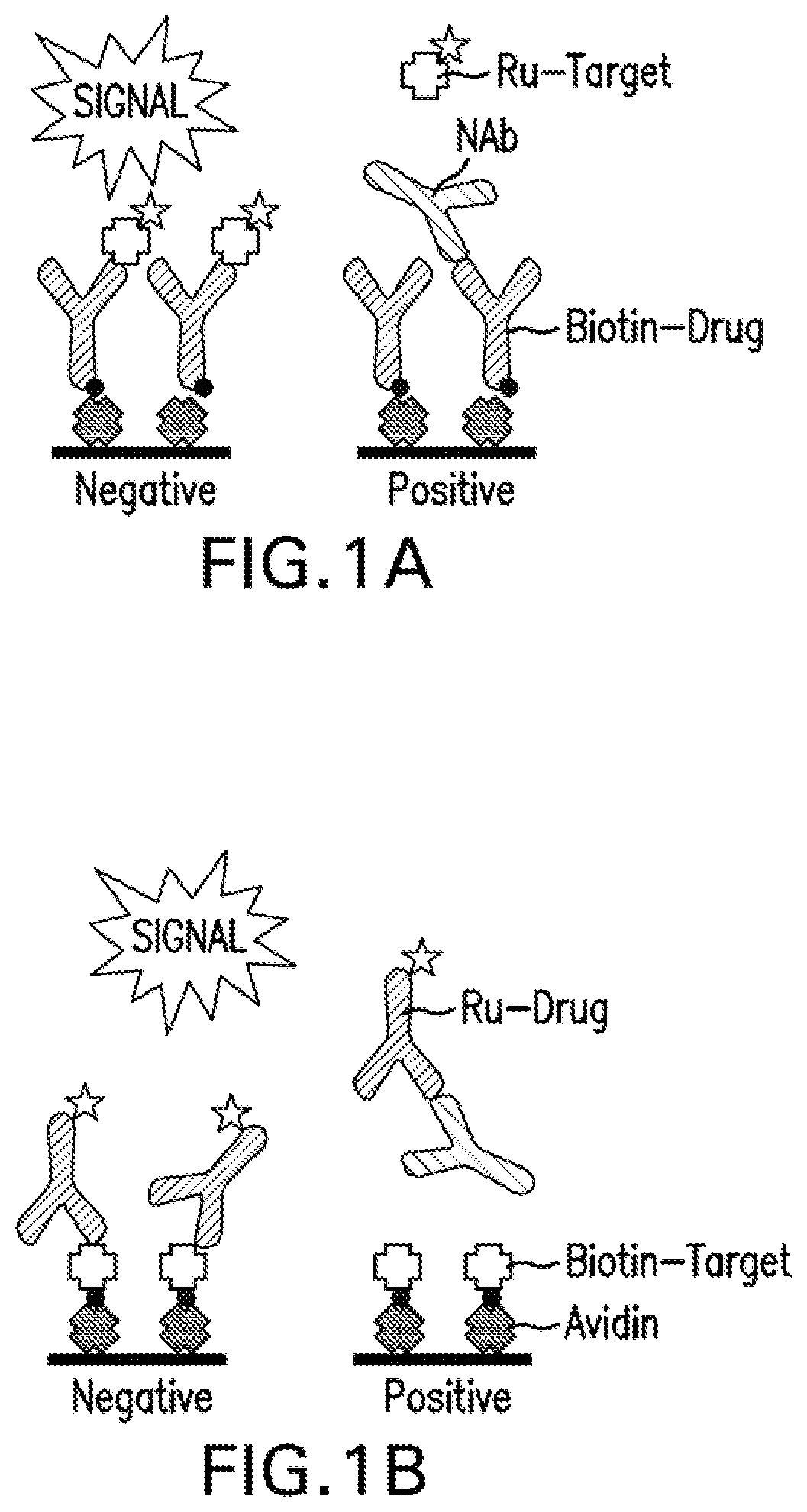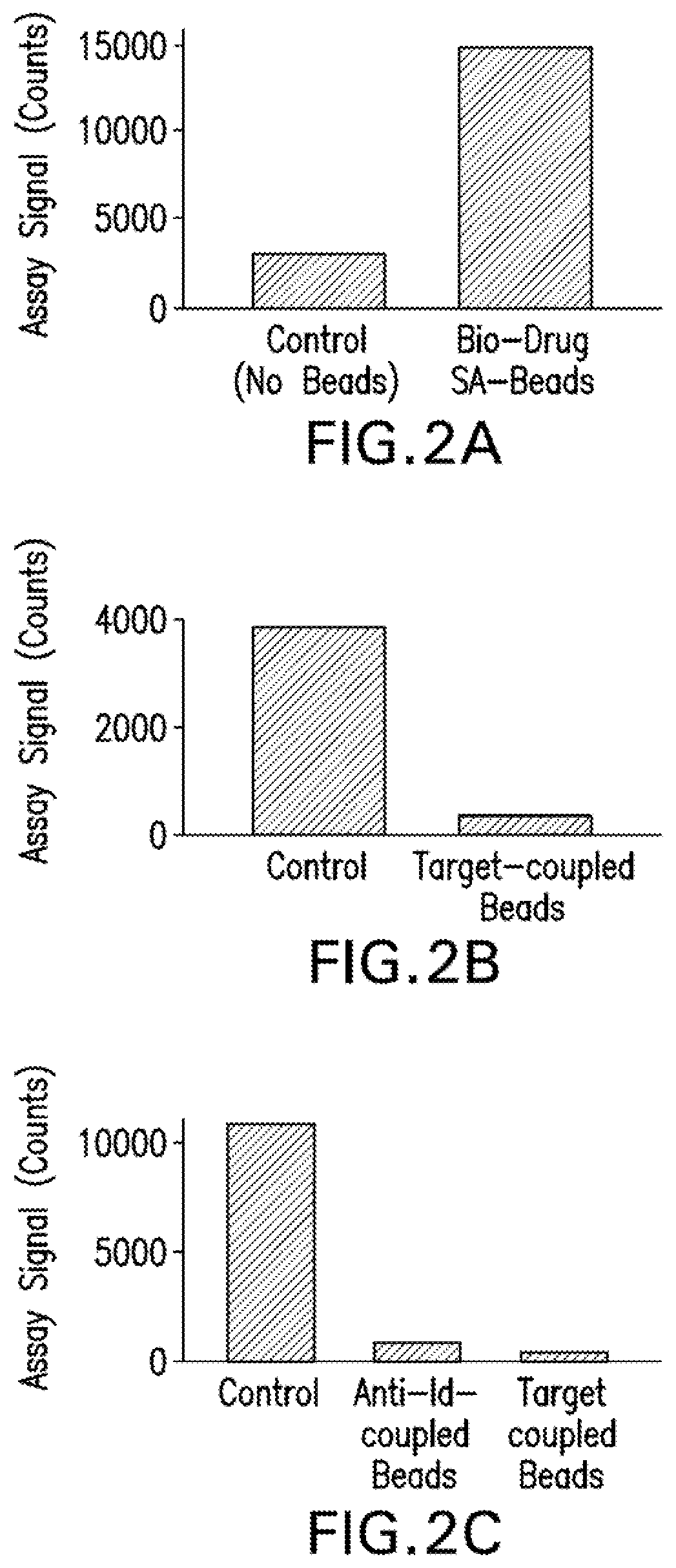Competitive Ligand Binding Assays
- Summary
- Abstract
- Description
- Claims
- Application Information
AI Technical Summary
Benefits of technology
Problems solved by technology
Method used
Image
Examples
example 1
ve Ligand Binding NAb Assays: Formats and Drug Tolerance
Materials and Methods
Materials and Reagents
[0071]All solutions, unless otherwise specified, were prepared in assay buffer (1% BSA in 1×PBS). Read Buffer T (4×) was from Meso Scale Discovery (MSD, Gaithersburg, Md.). Glacial acetic acid (17.4 M) was from Thermo Fisher Scientific (Waltham, Mass.). Human and monkey serum was from BiolVT (Westbury, N.Y.). The fully human monoclonal antibody drugs, the fully human competing anti-target A antibody, the recombinant human targets, the monoclonal, neutralizing anti-drug antibodies, used as the positive controls, and the anti-human monoclonal antibodies, were produced by Regeneron (Tarrytown, N.Y.). Labeling of antibodies and targets with biotin using EZ-link Sulfo-NHS-LC-Biotin (Thermo Fisher Scientific), and with ruthenium NHS ester (MSD), was performed according to the manufacturer's instructions. DyNAbeads™ Antibody Coupling Kit was from Thermo Fisher Scientific. Drug-specific protei...
example ii
of Bead-Coupled Protein to the NAb Assay Step
[0083]Materials and Methods
[0084]See Example 1.
[0085]Results
[0086]Initial experiments used a biotin-drug bound to a streptavidin bead to extract the ADA (and NAb) from the sample. However, in CLB NAb assays, low labeled drug concentrations are necessary to achieve maximum sensitivity (Hu, J. et al., J Immunol Methods, 419:1-8 (2015); Wu, B. W., et al., Competitive Ligand-Binding Assays for the Detection of Neutralizing Antibodies. In: Detection and Quantification of Antibodies to Biopharmaceuticals: Practical and Applied Considerations, Michael G. Tovey (Eds). John Wiley & Sons, Inc., Hoboken, N.J., USA. (2011)). Therefore, any biotin-drug transferred from the enrichment step to the assay step could interfere. Data in FIG. 2A demonstrates that biotinylated drug used in the NAb enrichment step carried over to the NAb assay step, resulting in ˜5-fold increase in assay signal. In fact, even in the absence of added biotin-drug in the NAb assa...
example iii
Interference from the Drug Capture Protein
Materials and Methods
[0088]See Example I.
Results
[0089]Attempts to reduce the amount of coupled protein or increasing the wash steps were unable to sufficiently minimize the interference from these proteins ater they were transferred to the NAb assay. In order to mitigate interference from carryover, a different approach was developed for each of the NAb assays.
[0090]When target was used as the capture reagent in the drug removal step, the protein carried over and inhibited NAb assay signal (FIGS. 2B, 2C and 3A). However, in the drug capture assay format, addition of an anti-target antibody solved the problem that arises from protein carry over. In the presence of the anti-target mAb, positive and negative control samples subjected the drug removal step with target coupled beads generated assay signal almost identical to control samples without the drug removal step (FIG. 3A).
[0091]In the target capture NAb assay format, the addition of anti-...
PUM
 Login to View More
Login to View More Abstract
Description
Claims
Application Information
 Login to View More
Login to View More - R&D
- Intellectual Property
- Life Sciences
- Materials
- Tech Scout
- Unparalleled Data Quality
- Higher Quality Content
- 60% Fewer Hallucinations
Browse by: Latest US Patents, China's latest patents, Technical Efficacy Thesaurus, Application Domain, Technology Topic, Popular Technical Reports.
© 2025 PatSnap. All rights reserved.Legal|Privacy policy|Modern Slavery Act Transparency Statement|Sitemap|About US| Contact US: help@patsnap.com



